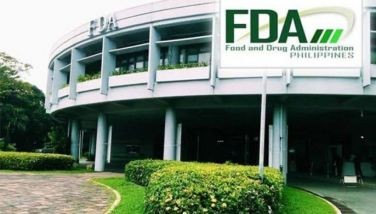Koyang Pete and Ate Josephine: Two deaths & an unfinished eulogy
(Editor’s note: Pedro Cojuangco, the eldest brother of former President Corazon C. Aquino, passed away last July 20 at 84. During his funeral Mass last July 26, his sister Josephine C. Reyes, 83, succumbed to death while delivering a eulogy. We asked the author to write on how these two deaths shocked and saddened one of the oldest political clans in the country.)
Losing a family member feels like losing a part of yourself. This is because a family member who passes away was once part of your life. It is with family members that one starts to build dreams. And the dreams of this particular family I speak about began with the migration of a Chinese gentleman HoSiKoHoWaNGKo from Amoy, China (translated in the alibapa as Jose Cojuangco) arrived in the Philippines.
A generation later, Jose’s son Melecio married Tecla Chichioco from Malolos, Bulacan who had four sons, Jose, Antonio, Eduardo and Juan. Two matriarchs dominated the Cojuangco family. Tecla from Hacienda Bakal in Talavera, Nueva Ecija and Malolos while Ysidra, her sister-in-law in Paniqui, Tarlac. Grandchildren, nephews and nieces, Ate Lulu, Antonio, Peping, Passy, Danding, Ditas, Rory, Isabel and Manoling treasure memories of their thriftiness and steadfastness.
In the late 19th century, Lola Tec would journey from Malolos to Manila on a carabao or horse-driven cart — not an air-conditioned van — to gather produce for her almacen in Malolos to sell imported linen, bagoong and salt, meat and vegetables. In Paniqui, Ysidra dealt in rice and money lending. Those were days of pioneers, when Tarlac was open territory for a person of foresight and industry. From their hard work the Cojuangco empire was built.
Cojuangco women have always played outstanding roles in the family. The very recently departed Josephine Cojuangco-Reyes was an educator, principal of the Far Eastern University girls’ high school, dean of the Institute of Arts, its president and chairman of the board of the Far Eastern University, and chairman of the Nicanor Reyes Medical Foundation. A hands-on matriarch, she was on top of every administrative function, from the financial aspects to regular meetings with the college deans. On her way out from the Nicanor Reyes Auditorium (named after her husband Noring) where her ashes were brought for necrological services, the loudest applause commemorated her achievements.
 Fiery ladies: Former President Corazon C. Aquino with Josephine C. Reyes
Fiery ladies: Former President Corazon C. Aquino with Josephine C. Reyes I loved her so that I chose Ate Jo to assist Peping in putting on my toga and cap for my graduation day at the University of Santo Tomas.
Marisse, who knew her mom was close to her brother Uncle Joe, said to my husband the day her mom died: “Please take care of us.” The lady in charge had left her family of 36 behind. During Ate Jo’s lifetime she recalled this amusing incident regarding her father: “Ready to load gas, the station attendant said to Papa, ‘Pahingi naman ng tip.’ ‘O sige,’ said Papa reaching for his wallet. The gas attendant said, ‘Hindi ho tip. Tip ho sa kabayo, dahil maraming kabayo ang anak ninyo.’”
The Cojuangco biographer, Marisse, wrote in Tide of Time that her mother would always be the tour manager whenever she traveled with her parents, bringing all the tickets and supervising the designation of rooms: “My grandfather was a neat, organized man, but my grandmother Metring held all the checkbooks,” referring to Demetria “Metring” Sumulong Cojuangco, the astute and determined matriarch, wife of Jose Cojuangco Sr.
It wasn’t easy in 1962 to be accepted into the huge Cojuangco clan. If there is a Cojuangco trademark, it would be their closeness, so that other people seem to feel shut out. The shyness, sometimes interpreted as arrogance, arises from the fact that there are certain nuances of cultural behavior that they alone understand and they are protective towards one another.
Marisse had this interpretation: “The Cojuangcos pride themselves on the closeness of their family ties.” She was asked who her friends were. “Apart from a few, I mostly named my cousins. Birthday celebrations usually meant sending invitations to other family members. Even at Malacañang gatherings, when we were invited by my aunt, the Jose Cojuangcos milled around together. With a few exceptions, we are timid in approaching acquaintances, and as a family, we stick together. In celebration and in grief, we are more comfortable being with each other. But our family, despite the fact that circumstances and history have forced us into the public eye, has tried to remain private.
“Among ourselves, we are careful in our actions, since we do not wish to hurt the feelings of any relative. We of the third generation do not wish to ‘lose face’ in the eyes of our elders, so we will exhaust all possibilities before asking a favor from one of them. This idiosyncrasy has caused many to raise an eyebrow about the Cojuangcos’ capability to do others a favor, especially during the time Auntie Cory was president. It is something the family understands, but to others it is an invisible wall that the Cojuangcos unintentionally put up, so that closest friends are not ‘in; on our deepest feelings, secret anxieties and fears.”
Anon-show of emotions is the result, something us in-laws understood eventually, by association with our spouses. The joke before was that the Cojuangco
women became hard of hearing because they heard nothing since their husbands hardly spoke. Cory would say, “My father really was a saint. My mother was the stronger of the two. But when my father died, she was completely lost.”
I witnessed the hurt and apprehensions of this great family that withstood financial difficulties and heartbreak during those dark years of martial law. It was something Koyang Pete had encountered in 1963 when his bank, First United, which Papa had organized on his own without his brothers, was threatened by new banking regulations established by the Central Bank in the years of martial law. Koyang Pete explained that the First United Bank needed partners to meet the new regulations regarding paid-up capital to merge with another bank.
“Every time we would discuss a merger with somebody, it would always end up with ‘Let’s clear this up first with the Central Bank.’ The Central Bank would tell potential bank partners, ‘Clear it up first with Malacañang,’” leading all transactions to nothing, after being squeezed by the Marcos machinery. The family finally sold First United Bank to Danding Cojuangco, their cousin.
The Harvard-educated Koyang Pete related other difficulties of the family, particularly with regard to Pantranco, another family-owned company. Pantranco desperately needed new buses after the giant floods of 1971 and 1972, which devastated the roads of Central Luzon. Pantranco applied for a fare increase through the Public Service Commission. Hino, a Japanese company, offered to sell buses to Pantranco if the Philippine National Bank could guarantee a loan to the Cojuangcos. The answers were always “no” and the companies were taken over by the Marcos government.
 The Cojuangcos: Pedro Cojuangco (seated, second from right) with Passy Teopaco, Jose Cojuangco, Josephine Reyes, Cory Aquino and Teresita Lopa. Standing are Sari Cojuangco, Esting Teopaco, and Tingting Cojuangco
The Cojuangcos: Pedro Cojuangco (seated, second from right) with Passy Teopaco, Jose Cojuangco, Josephine Reyes, Cory Aquino and Teresita Lopa. Standing are Sari Cojuangco, Esting Teopaco, and Tingting Cojuangco Yet the Jose Cojuangcos weathered every difficulty because we were taught to act as one and obey the head of the family, never to speak against each other, keep feelings to ourselves, especially if they ran contrary to the thoughts, wishes and decisions of the eldest member who held the reins. In fact I would hear my children tell their dad “Dapat sinasabi mo na” from the results of the family board meetings. Ate Jo and Peping would say, “Ah sabi ni Koyang kasi…” Our children decided with their cousins to attend the board meetings with the adults’ permission. They settled the order of business. Faster, straightforward, quite frankly — but deferring to the head of the family, Koyang, again for his perusal. One signal, one feeling, no words needed to be uttered and they complied. Even if no member of the family forced the others to follow, everyone simply complied.
The six days of Koyang’s wake was a celebration of his life. They were sad days primarily but the Tarlac priests reminded us of Koyang Pete’s kindness. Three days before he died Sari and their son Mel brought Koyang to the hospital. One call from one member of each family was enough to “pass the word” about family, occasions and news. It was kept from us.
As our children and their cousins grow older they no longer tell us seniors of their family emergencies so as not to worry us. They take care of what they can, but one time Liaa texted her dad: “Uncle Pete doesn’t look well. Come to the I.C.U. tomorrow, take your Tranxene now.” Three days later Pedro Cojuangco and family members crowded the main hallway of the Makati Medical Center waiting for Liaa and Jake to prepare Koyang’s lifeless body for us to pray over him. Sari said, “He was wobbly, he couldn’t keep his balance. Me acuerdo ahora que (I remember now that) Pete would say loudly. ‘I love you, Sari Cacho.’” If flowers indicated the affection for the man who died from kidney infection that spread to his pancreas, he had hundreds of white flowers, so many that Ate Jo commented, “When I die, I want colored flowers.”
The day of his burial heavy rains matched our melancholy mood. Traffic had caused a delay in the ceremonies with Sari and her family arriving late and with Ate Jo and her daughter Marisse Reyes also arriving from Wack Wack, like Sari. The Mass proceeded with Mikee as the lector for her Ninong Pete with readings from Joel Cojuangco-Lopa. Koyang and Sari’s granddaughter Margarita, son-in-law JM Araneta and Marisse Cojuangco-Reyes.
“Our brother Pete has fallen asleep in the arms of Christ. Let our grief and sorrow change to rejoicing. The Mass is ended, thanks be to God.”
It was time for the eulogy and Ate Jo was escorted to the altar of San Antonio Church by Peping with smiles from a private joke they exchanged. She stood and began:
“Good morning. At family gatherings or even when we just sat around the table we eventually talked about the memorable good old days. Here are a few of those recollections. Papa and Mama’s first child was stillborn and named Ceferino. After him, Koyang and I were born, just a year and a month apart. Terry Lopa came next. After her, we lost a sister Carmen who succumbed to meningitis at age one year and a half. Our only memory of her was a big picture in Papa and Mama’s bedroom. Our house on 1259 Agno St. Malate and other houses on that street were burned by the retreating Japanese soldiers during the liberation of Manila. Then came Cory, Peping and Passy.
“Papa and Mama were always taking care of business in Tarlac and so we were left in the care of our aunts and uncle, first in Sampaloc and then in 1259 Agno. The blessing of that house coincided with the year of Cory’s birth, 1933. So many happy memories.
“Being of Chinese ancestry, Koyang was the ‘favorite’ – he was the eldest and he was male. I got just as many academic awards as Koyang but only he got the Hills Brothers coffee cans filled with coins from Lola Tecla — Papa’s mother. In those days ordinary people, much less children, did not have bank accounts. Banks were for big business and rich city dwellers.”
 Family portrait: Josephine C. Reyes and Nicanor Reyes III (center) with their children and grandchildren. Standing are Anton Reyes, Quincy Reyes, Nicole Reyes, Martina Reyes, Natalia Reyes, Mika Reyes, Ivanna Reyes, Kym McMurray, Jenna Reyes, Bianca Reyes, Oshy Reyes, (second row) Katrice Reyes Tucci Reyes, Kyler Reyes, Kit Reyes, Marisse Reyes, Linda Reyes, Maxwell Reyes, (third row) Keryn Reyes, Kij Reyes, Jeffrey Reyes, Via Reyes, Jaybee Reyes, Michelle Sacramento, Jay Sacramento, Juna Miguel Reyes, Annavi Reyes, Keith Reyes, Nino Reyes, Rowena Reyes, Ritchie Reyes
Family portrait: Josephine C. Reyes and Nicanor Reyes III (center) with their children and grandchildren. Standing are Anton Reyes, Quincy Reyes, Nicole Reyes, Martina Reyes, Natalia Reyes, Mika Reyes, Ivanna Reyes, Kym McMurray, Jenna Reyes, Bianca Reyes, Oshy Reyes, (second row) Katrice Reyes Tucci Reyes, Kyler Reyes, Kit Reyes, Marisse Reyes, Linda Reyes, Maxwell Reyes, (third row) Keryn Reyes, Kij Reyes, Jeffrey Reyes, Via Reyes, Jaybee Reyes, Michelle Sacramento, Jay Sacramento, Juna Miguel Reyes, Annavi Reyes, Keith Reyes, Nino Reyes, Rowena Reyes, Ritchie Reyes To our surprise she then paused and said, “I am sorry, I cannot continue this eulogy, I’m dizzy.” Peping approached her when she grasped the podium and caught her as she fell backwards. Our niece Marla C. Teopaco and my daughter Liaa rushed to the altar believing she had merely fainted. Family members sat perplexed. The members of the family who were doctors rushed up to the altar. Two from Cojuangco-Rivilla’s side. Dr. Suey C. Rivilla and Marla Rivilla Tan, rushed up with Suey’s husband Dr. Jake Manalastas, Liza Cojuangco, Danding and Gretchen’s daughter married to Dr. Nick Cruz, head cardiologist at St. Luke’s. Jojou Sumulong-Bautista, married to Dr. Maria Imelda Bautista, head pediatrician of St. Luke’s, and Liaa tried painstakingly to revive Ate Josephine at the altar of San Antonio Church with Noy’s doctor and nurse. There was also Dr. John Gomez.
As Ate lay behind the podium, Liza rushed to get her father Danding’s first aid equipment and brought it up to the altar. Passy, who had gone to the altar, said “Ate… Ate…” to wake up her sister. Liaa and Marla called “Auntie Jo… Auntie Jo…” Air and oxygen were administered. Pin embraced Marisse and her dad. Esting stood stoic.
The doctors took turns pumping her chest to resuscitate her. Dr. Marla Tan attached the dextrose with the Malacañang doctor who had brought the emergency equipment from the President’s ambulance. Everyone in the church sat transfixed in their pews. Ate Lulu Cojuangco-Revilla gave Mikee a prayer book for the mourners to pray the rosary. Family shawls were brought up to cover the medical proceedings and I knelt with China and Celda to cover Ate. Six other priests and Father Jerome behind the doctors blessed Ate who had just received Holy Communion by the coffin of her brother Pete. Ate’s children, Linda, Kit, Tucci and Marisse, stared like us in disbelief. We were shocked by the unexpected proceedings. After almost an hour Dr. Nick Cruz decided with Jake Manalastas that Ate Jo should be brought to St. Luke’s. The doctors put her on the gurney. We covered her body with a black shawl. What a difficult decision it was for Peping and Passy to make: whether to remain with Koyang Pete or follow Ate Jo. I told Peping that his brother-in-law Esting Teopaco and I would stay with Sari. Celda and Marla asked their mother what she wanted to do. “I have to think,” she answered but Peping and Celda took Passy with them down the aisle for the hospital trip.
At St. Luke’s, Ate could not be revived. Forty-five minutes later she was formally pronounced dead from ventricular arrhythmia. Her children were beside her with Rina, Kris, China, Peping and Passy.
On our way to the cemetery, for Koyang’s burial, China told us Ate had expired. What a tragic day for us but God in His wisdom had blessed Ate. She died by the altar of God, below His feet. That was our consolation. To quote Father Kennedy of Tarlac, “It is my dream to die also by the altar of God.”
The continuation of her eulogy follows, as it was read by Marisse at the funeral Mass of Ate Jo the evening of Koyang Pete’s morning burial:
“Koyang knew the history of the First United Bank and was more than qualified to work there. Koyang finished elementary and high school in La Salle Taft, always at the head of his class. He received the Edward Dougherty award for general and academic excellence from Manhattan College in New York 1949 and got his master’s in business administration from Harvard University Business School. Then he returned home. He rose from the ranks — starting as executive assistant to the EVP before he became the president of FUB, now UCPB.
“If you are old enough you will remember the Andrew Sisters, Song Rum and Coca-Cola. Papa was the manager of Paniqui Sugar Mills which was still standing after WWII. During the Liberation, an American tank destroyer battalion took up camp in the Ysidra Cojuangco compound. The central had not been destroyed by the retreating Japanese or shelled by advancing Americans. Providentially, a ‘good soul’ had left a surplus of panocha (hardened molasses shaped like a half of queso de bola.) A chemist, Mr. Batenga, provided the formula for converting panocha into rum, so they were able to generate money.
“The main house was occupied by the American generals. We offered them drinks which were really made from alcohol from the distillery. They would bring Coke syrup and mix it with our alcohol to get drunk. In the morning, they felt good because alcohol made from molasses does not give you a hangover. They said the alcohol was good. We were asking the Americans to give us gasoline for an old jalopy, a 1920 Model T Ford. The car was so old the door wouldn’t open when Mama’s sister Lumen Boncan was trapped inside. When we told them the car we rode in ran on alcohol, they asked, ‘The same alcohol we were drinking? Don’t use the alcohol, we’ll give you gasoline.’ We started a distillery and sold Paniqui Rum for P8; a bottle of whiskey was already selling at P60.
 Family ties: Jose S. Cojuangco Sr. and Demetria S. Cojuangco (third and fourth from right) with children Passy Teopaco, Josephine C. Reyes, Teresita Lopa, Corazon C. Aquino, Jose S. Cojuangco, and Pedro Cojuangco
Family ties: Jose S. Cojuangco Sr. and Demetria S. Cojuangco (third and fourth from right) with children Passy Teopaco, Josephine C. Reyes, Teresita Lopa, Corazon C. Aquino, Jose S. Cojuangco, and Pedro Cojuangco “Word got around and Paniqui Rum was sold to American GIs in San Fernando, La Union and Okinawa. The line of trucks would wind from the Central all the way out to buy alcohol. So many other stories about Paniqui Rum. Koyang, who was 18 years old, was in charge of the sale of rum. When he finally left Paniqui for Manila he had sold $4 million worth, packed in sacks and loaded in two army trucks. Koyang said PNB had to count again just to make sure they had counted it right.
“Koyang was 20 when we left for New York in 1946. Papa, Mama, all six of us, together with Monching Cojuangco and Lulu Cojuangco Rivilla with their cousin Tommy Lim, US-bound on a converted troop ship — the General Gordon. Many Filipinos were onboard, most of them family acquaintances, to study in the US. I think it took 21 days to reach our destination; not a comfortable trip, I tell you. After a few days’ stay in San Francisco, we all took the cross-country train to New York City to study in our respective schools — Koyang to Manhattan College, myself to Marymount, Tarrytown, Terry and Cory to Ravenhill in Pennsylvania, Peping to Loyola School in Manhattan, Passy in a day school. It was a wish of Papa to have a family picture taken with all of us in caps.
“Koyang was the consummate ‘Big Brother.’ You could go to him whenever you were in need. Sometimes you didn’t even have to ask. When my children and I relocated to New York City, Koyang would send me a monthly stipend without fail. Forever a caring brother. In fairness, Peping is also like that.
“On behalf of Peping and Passy and all the members of the family that Koyang has left behind, thank you and our deepest appreciation to all who expressed their sympathy in one way or another.
“God bless us all.”
God bless them both, whom we respected and loved so, so much: Koyang Pete and Ate Jo.















